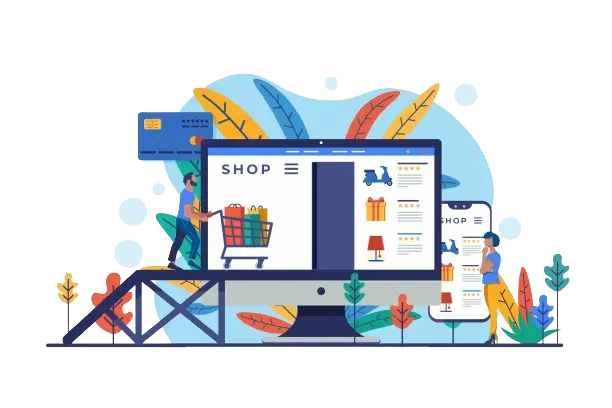
Introduction: What is a Multi-Vendor E-commerce Marketplace?
A multi-vendor e-commerce marketplace is an online store that facilitates the sale of products and services from multiple vendors. It serves as an intermediary, connecting buyers with a network of sellers and providing a platform for them to reach new markets and customers.
Some key characteristics of multi-vendor marketplaces include:
- Aggregation of demand: Multi-vendor marketplaces aggregate demand for sellers, curating the right products for buyers and ensuring an exceptional shopping experience.
- Cost-effective entry: Marketplaces offer a cost-effective entry into either B2C or B2B e-commerce.
- Wide range of products: Customers can buy products from different sellers or brands, providing a diverse range of products and services.
- Logistics management: Marketplace operators are responsible for ensuring logistics standards across all sellers and managing custom integrations.
- Fintech and compliance: Marketplaces must validate their vendors, ensure they can pay them out, and remain compliant with their fintech provider.
Some popular examples of multi-vendor e-commerce marketplaces are Amazon, eBay, and Etsy. To create a multi-vendor marketplace, you can either build it from scratch, which requires custom e-commerce development, or use a purpose-built multi-vendor marketplace platform. These platforms offer universal functionality and best practices, allowing you to launch and manage your marketplace more efficiently
Benefits and Advantages of a Multi-Vendor E-commerce Marketplace
The benefits and advantages of a multi-vendor e-commerce marketplace include:
- Wide Range of Products: Customers have access to a vast range of products from multiple sellers, enhancing the shopping experience and providing more options to choose from.
- Profitability: Multi-vendor marketplaces are frequently more profitable than other e-commerce businesses, as they do not have the additional expenses associated with product creation, inventory, and delivery.
- Easy Setup and Scalability: Setting up a multi-vendor marketplace is relatively easy, and it offers scalability, allowing for the expansion of the business without incurring significant overhead costs.
- Popularity and Convenience: Multi-vendor marketplaces are popular and convenient for both customers and sellers, as they provide a one-stop shop for a wide variety of products and services.
- Cost-Effective Entry and Commission Income: For vendors, a multi-vendor marketplace provides a cost-effective entry into e-commerce and the opportunity to reach new markets and customers. Additionally, the marketplace can earn commission income on sales made by vendors.
- Logistics Management and Fintech Compliance: Marketplace operators are responsible for ensuring logistics standards across all sellers and managing custom integrations. They must also validate vendors, ensure they can be paid, and remain compliant with fintech providers
The Key Features and Functionality of a Successful
Multi-Vendor E-commerce Platform
A successful multi-vendor e-commerce platform should have the following key features and functionality:
- Ease of Use: The platform should be intuitive and easy to understand for both vendors and customers.
- Maintenance and Security Features: The platform should have robust maintenance and security features to ensure the safety of customer data and prevent fraud.
- Customer Support: The platform should offer customer support to resolve any issues that may arise during the buying process.
- Cost of Adoption: The platform should be cost-effective for vendors to join and sell their products.
- Store Management Features: The platform should provide vendors with control over their business, including managing products, delivery time, price, and modes of shipping.
- Reporting and Analytics: The platform should offer reporting and analytics features to help vendors track their sales and optimize their business.
- Advanced Search Features: The platform should have advanced search features to help customers find the products they are looking for quickly and easily.
- Multiple Payment Gateways: The platform should support multiple payment gateways to provide customers with a range of payment options.
- Enchanting Design: The platform should have an attractive and responsive design that meets market expectations and enhances the shopping experience
The Development Process: Steps to Create a Robust
Multi-Vendor E-commerce Marketplace
To create a robust multi-vendor e-commerce marketplace, the following steps are essential:
- Define Your Marketplace Concept: Determine the niche, target customer profile, types of products or services, and unique selling proposition of your marketplace. Conduct competitor analysis to make your offer distinctive.
- Select a Multi-Vendor Marketplace Platform: Choose a purpose-built multi-vendor marketplace platform that offers universal functionality and best practices, allowing for efficient marketplace launch and management.
- Software Solutions for Multi-Vendor Marketplace Development: Consider popular options such as Adobe Commerce, WooCommerce, or other multi-vendor marketplace software solutions that provide features like vendor registration, product listing, order processing, commission management, and more.
- Develop and Launch a Multi-Vendor E-Commerce Marketplace MVP: Create a Minimum Viable Product (MVP) to test the market with fewer resources. This phase lays the groundwork for a strong, customer-focused multi-vendor e-commerce platform that evolves based on practical findings and user feedback.
- Vendor Acquisition and Management: Ensure the platform handles vendor acquisition and management efficiently to attract and retain quality sellers.
- Cost-Effective Entry for Vendors: Make the platform cost-effective for vendors to join and sell their products, as this can attract a wide range of sellers.
- Customer Support and Security Features: Provide robust customer support and security features to ensure a safe and seamless experience for both customers and vendors.
- Enchanting Design and User-Friendly Interface: Create an attractive and user-friendly design to enhance the shopping experience for customers and provide an intuitive interface for vendors to manage their stores



